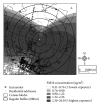A review of exposure assessment methods in epidemiological studies on incinerators
- PMID: 23840228
- PMCID: PMC3694556
- DOI: 10.1155/2013/129470
A review of exposure assessment methods in epidemiological studies on incinerators
Abstract
Incineration is a common technology for waste disposal, and there is public concern for the health impact deriving from incinerators. Poor exposure assessment has been claimed as one of the main causes of inconsistency in the epidemiological literature. We reviewed 41 studies on incinerators published between 1984 and January 2013 and classified them on the basis of exposure assessment approach. Moreover, we performed a simulation study to explore how the different exposure metrics may influence the exposure levels used in epidemiological studies. 19 studies used linear distance as a measure of exposure to incinerators, 11 studies atmospheric dispersion models, and the remaining 11 studies a qualitative variable such as presence/absence of the source. All reviewed studies utilized residence as a proxy for population exposure, although residence location was evaluated with different precision (e.g., municipality, census block, or exact address). Only one study reconstructed temporal variability in exposure. Our simulation study showed a notable degree of exposure misclassification caused by the use of distance compared to dispersion modelling. We suggest that future studies (i) make full use of pollution dispersion models; (ii) localize population on a fine-scale; and (iii) explicitly account for the presence of potential environmental and socioeconomic confounding.
Figures




References
-
- Eurostat. Eurostat statistical books. Environmental statistics and accounts in Europe 2010. 2010 Edition. European Union, 2010.
-
- Saner D, Blumer YB, Lang DJ, Koehler A. Scenarios for the implementation of EU waste legislation at national level and their consequences for emissions from municipal waste incineration. Resources, Conservation and Recycling. 2011;57:67–77.
-
- Reis MF. Encyclopaedia of Environmental Health. 2011. Solid waste incinerators: health impacts; pp. 162–217.
-
- Allsopp M, Costner P, Johnston P. Incineration and human health: state of knowledge of the impacts of waste incinerators on human health (executive summary) Environmental Science and Pollution Research. 2001;8(2):141–145. - PubMed
-
- British Society for Ecological Medicine. The Health Effects of Waste Incinerators 4th Report of the British Cociety for Ecological Medicine. 2nd edition 2008.
Publication types
MeSH terms
Substances
LinkOut - more resources
Full Text Sources
Other Literature Sources

